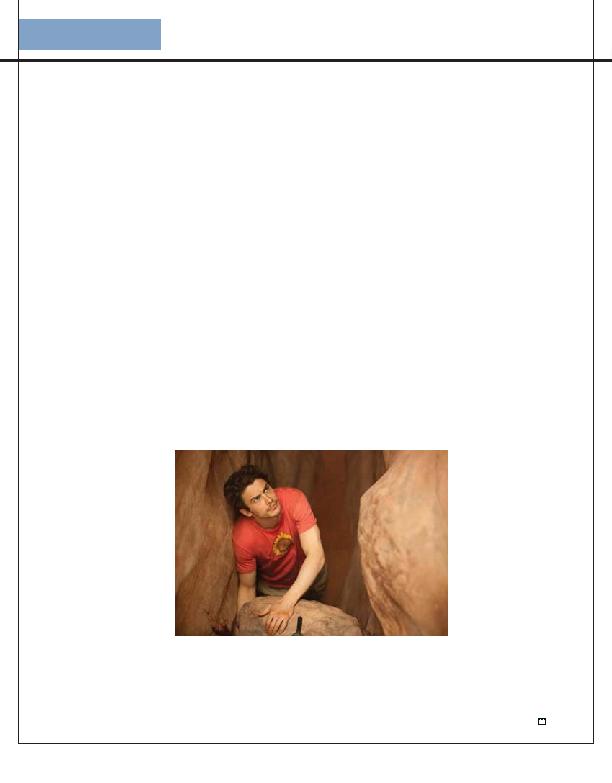
-- the real story behind 127 Hours is about
how co-writers Simon Beaufoy and Danny
Boyle (the director's first writing credit) man-
aged to expertly adapt a nearly unadaptable
book and toss in an unforgettable ending to
boot. Although Beaufoy and Boyle discussed
their process of adapting Aron Ralston's true
adventure, "Between a Rock and a Hard
Place," in the November/December 2010
issue of Creative Screenwriting, what wasn't
discussed was how they saved the ending --
and also the film.
ing than what was seen in the finished film.
A look into the 101-page "Revision: Buff
Pages" version of the shooting draft, dated
April 10, 2010, contains a full 20 pages of
material after Aron (James Franco) frees him-
self from the rock on page 81.
a musically rich and rushed denouement that
seems as though Aron is on the last legs of this
incredible race that we've been rooting for him
to finish all along. Sure he scales down a wall
and drinks some water, but from
that moment forward his rescue
is a fully immersive and emo-
tionally poignant blur concluded
by a brief credit sequence that
shows what Aron has done since
this event. It's a fantastic con-
clusion because it escapes the
more predictable and traditional
resolution in which Aron apol-
ogizes to friends and family and
makes good on some of his
canyon promises. While the
film's ending smartly skips all
those expected beats, sadly the
script didn't.
Aron's rescuers, has a quarter-page mono-
logue recounting how he rescued Aron,
which he details on a TV show. This com-
pletely interrupts the flow of the rescue,
which is flashed back to, and was one of
many good cuts made as momentum begins
fading on the page in this section.
the script and film have been a raw man-ver-
sus-nature-versus-himself type of tale, but
here it slides into melodrama.
that to me again and I swear
I'll break both your legs.
bandages, the place where his
hand should be, realises for
the first time that a new life
starts here. Suddenly scared,
his eyes fill with tears.
That's all that matters for
now.
which time he resolves to treat his family
better, so there's too much pressure for a
short scene like this to accomplish all that's
had to go. At the conclusion of this scene in
the original script, a title flashes up that
reads, "1,000 Hours Later."
tending his sister Sonja's wedding -- which he
on the video message he made in the canyon.
Again, the script wears its heart on its sleeve as
Aron's father makes a schmaltzy speech.
play it together -- just as he promised. The
scene runs nearly a page and, again, does-
n't top any of the energy or emotion from
the canyon.
scene, he explains how there's still another
hike he wants to finish ("the fourteeners")
and tells her of the vision he had of his un-
born child, which helped fuel his painful es-
cape. After a silence he asks, "But it's not
going to be you, is it?" She replies, "No, Aron,
it's not," and then chides him for planning
to return to the wilderness by saying, "Every-
one who cares for you, a little bit of them
dies each time you go back out there." The
script then finishes with titles similar to
those seen in the final film.
material, showed it to a small group of
friends, one of whom commented that he
conventional ending to
such an unconventional
film. This was all Boyle
needed to hear to motivate
a jump back into the editing
room and a bold refusal to
be precious about his and
Beaufoy's writing. Ulti-
mately, he re-cut the ending
into something that
matches the heart pounding
nature of the film, an end-
ing that would better res-
onate with audiences.
As Boyle and Beaufoy proved,
film was shot), there's often riches to be
found by remaining open to smart notes,
particularly ones that necessitate big, but im-
portant changes. If this Oscar-winning team
is versatile enough to know when to take a
smart note -- you should be, too!